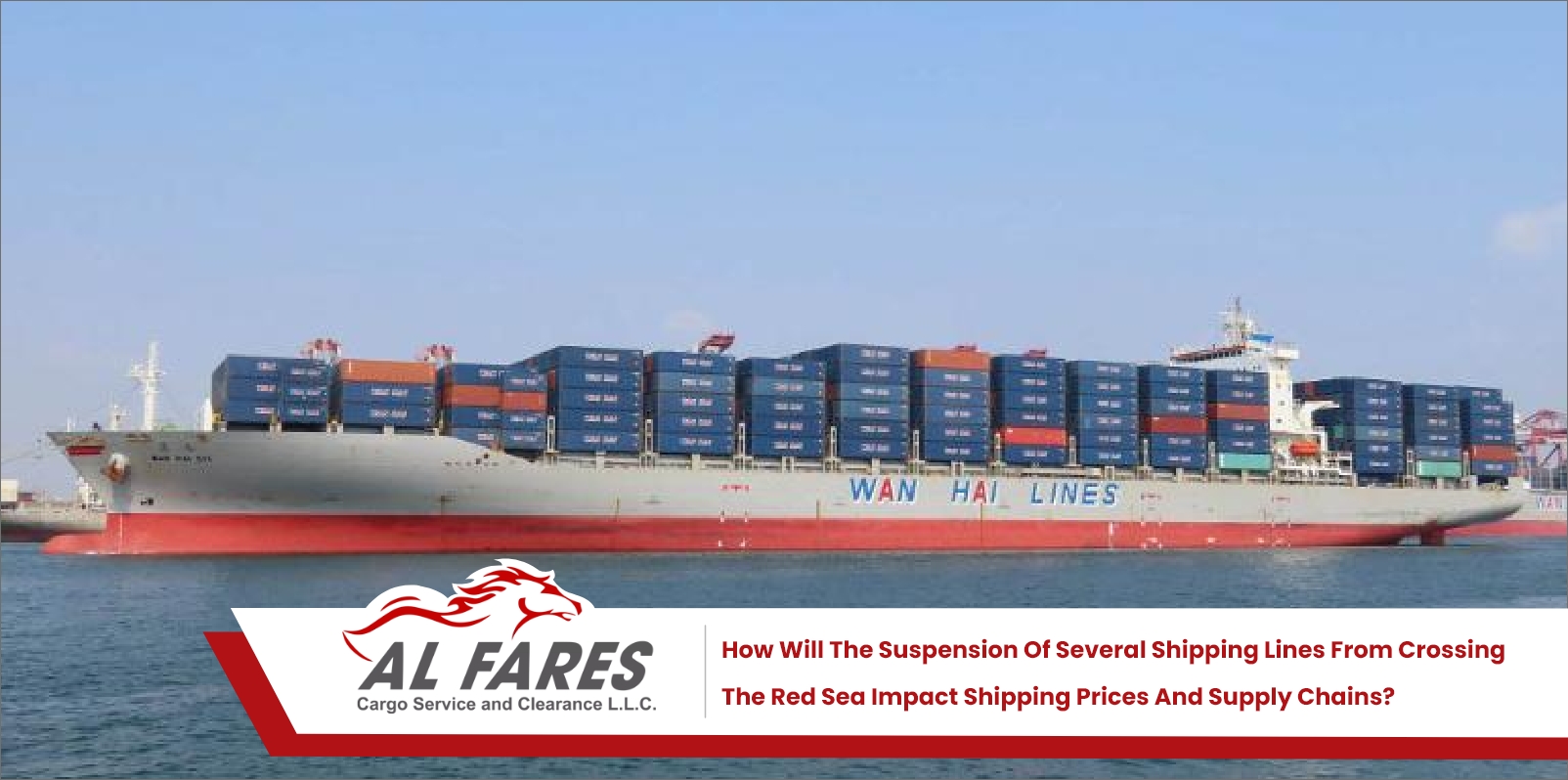Shipping and supply chains are among the most critical businesses in the world today, playing a crucial role in securing the movement of goods, essential materials, and products globally. Maritime navigation is a key method for transporting these goods between continents, with the Red Sea serving as a vital maritime passage.
The suspension of several shipping lines from crossing the Red Sea could pose a wide range of challenges and issues. For instance, goods that were previously transported via these shipping lines may now face difficulties reaching their intended destinations quickly and efficiently. This delay in the distribution of products and essential materials may lead to increased demand and supply for available goods, potentially resulting in higher prices.
In this article, we will shed light on the various impacts that the halting of several shipping lines from crossing the Red Sea may have on shipping prices and supply chains, outlining the key challenges and problems arising from this interruption.
Key Challenges and Issues Arising from the Halting of Several Shipping Lines from Crossing the Red Sea:
First: Impact on Shipping Prices:
The suspension of several shipping lines from crossing the Red Sea will have a significant impact on shipping prices in the global market. These effects will be evident through the following points:
1.Increased Costs of Alternative Transportation:
The cessation of maritime navigation in the Red Sea forces shipping companies to seek alternative ways to transport goods and materials. Among these alternatives are air transport and trucking, both of which typically incur much higher costs than maritime transportation. Consequently, shipping costs will rise, and these additional expenses will eventually be passed on to companies and consumers.
2.Rising Fuel Costs:
With shipping lines halted in the Red Sea, maritime vessels will be compelled to take longer alternative routes to reach their destinations. These alternative routes usually require more fuel, leading to increased fuel costs. As fuel costs rise, it will be reflected in shipping prices, as companies will need to raise transportation costs to cover the additional fuel expenses.
3.Supply and Demand Dynamics:
The sudden halt of shipping lines in the Red Sea will reduce the available supply for shipments through this vital waterway. When supply decreases, demand for alternative services, such as air transport and trucking, will increase. This surge in demand will result in heightened competition among companies for alternative transportation services, leading to increased shipping prices.
4.Higher Insurance Costs:
The maritime suspension in the Red Sea implies that vessels will have to take alternative routes, potentially increasing the risks associated with transportation. When ships travel through unfamiliar alternative routes, there is a higher risk of accidents and issues that could impact shipments. This means that shipping companies will have to pay additional costs to insurance companies to cover these additional risks, undoubtedly contributing to increased shipping costs.
Secondly: Impact on Supply Chains:
The suspension of several shipping lines from crossing the Red Sea will significantly impact supply chains in various industries and sectors. This impact will have profound consequences, as outlined in the following points:
1.Supply Chain Disruption:
The halt of maritime routes in the Red Sea implies that shipments and goods will not reach their intended destinations on time. This delay in delivering goods could lead to disruptions in the supply chain across various industries. For example, if shipping lines cease transporting crucial raw materials for a specific industry, it may result in shortages of raw materials and disruptions in production processes. This, in turn, affects product availability in the market, leading to reduced supply, increased demand, higher prices, and disruptions in supply chains.
2.Impact on Productivity and Production:
The cessation of maritime operations in the Red Sea will cause delays in delivering essential components and materials needed for production. This delay can impact the productivity of companies and their ability to meet demand. For instance, if shipping lines stop transporting vital components for a particular industry, companies may struggle to maintain their usual production rates, leading to decreased productivity. Reduced productivity can result in the loss of demand and customers, negatively affecting the company's business and profitability.
3.Impact on Global Supply Chains:
The Red Sea is a crucial part of global supply chains, with many commercial ships and containers crossing it to transport goods between continents. If shipping lines cease operations in this sea, it could cause disruptions in global supply chains and delays in delivering goods to numerous countries. This delay may affect multiple industries, and its impacts could accumulate across various economic sectors.
Thirdly: Economic Impacts:
The suspension of several shipping lines from crossing the Red Sea can lead to significant economic effects on the surrounding region and the global economy as a whole. In this explanation, we will analyze potential economic impacts and the factors contributing to these effects.
1.Impact on International Trade:
The Red Sea serves as a vital maritime passage used by many traders and companies for transporting goods and commodities between countries. If shipping lines cease operations in the Red Sea, it could result in significant disruptions to global supply chains and delays in the delivery of goods. This delay may lead to increased shipping costs and delays in international trade. Consequently, there might be a decline in trade volume and a slowdown in global economic growth.
2.Shipping and Transportation Costs:
The suspension of shipping lines in the Red Sea forces companies and transport operators to seek alternative methods for transporting goods and commodities. Typically, these alternative methods are more costly than maritime transport. The use of air transport or trucking increases shipping and transportation costs in general. These additional costs may eventually be passed on to consumers through higher prices for products and services.
3.Impact on the Transport and Logistics Sector:
The cessation of shipping lines from crossing the Red Sea can significantly impact the transport and logistics sector. An efficient and sustainable transport network is essential to ensure the smooth movement of goods and commodities to and from the region. If shipping lines are halted, it could lead to disruptions in logistics, shipment delays, and an overall increase in transportation costs. Transport operators and shipping companies may need to implement alternative measures, such as using land or air routes, which could increase transportation costs and have a negative impact on the sector.
Fourthly: Impact on Global Trade Patterns:
The suspension of shipping lines in the Red Sea may lead to effects on global trade patterns. When the maritime passage becomes less viable, companies and countries will be compelled to seek alternative means to meet their shipping needs. This involves considering the use of alternative transportation methods such as land or air transport.
The impact of this is an increase in costs and the complexity of supply chains. Maritime transport is typically the most efficient and cost-effective means of transporting goods over long distances. However, when the maritime passage is halted, companies and countries may have to rely on alternative modes of transport such as land (via roads) or air transport.
When utilizing these alternative means, operational costs may significantly increase. For instance, land transport requires higher fuel consumption and incurs maintenance costs and customs fees at borders. Air transport, on the other hand, is generally much more expensive than maritime transport and involves strict security procedures, complexities in storage, and customs clearance.
Additionally, changing modes of transport can complicate supply chains. When companies are accustomed to using the maritime passage as a primary shipping route, they follow a specific supply system that relies on this passage. However, when this system changes due to the suspension of shipping lines, a restructuring of supply chains is necessary to align with the alternative transportation methods being used.
Fifthly: Environmental Impacts:
The environmental impact resulting from the suspension of shipping lines in the Red Sea and the use of alternative transportation for goods. When alternative transportation methods such as land or air transport are employed, it can lead to various environmental effects, including the following:
1.Increased Carbon Emissions: Land and air transport typically require higher fuel consumption than maritime transport, leading to increased emissions of carbon dioxide (CO2) and other greenhouse gases. This contributes to higher concentrations of carbon in the atmosphere and climate change.
2.Air Pollution: Land and air transportation contribute to air pollution resulting from fuel combustion. This leads to the emission of harmful air pollutants such as particulate matter and nitrogen oxides, negatively impacting air quality, human health, and ecosystems.
3.Impact on Marine Ecosystems: Changes in shipping patterns can affect marine ecosystems in the Red Sea region. The increased use of land transport may necessitate the construction of roads and logistical facilities, potentially causing environmental destruction and negative effects on the plants and animals in those areas.
4.Long-Term Environmental Effects: Altering shipping patterns may have long-term environmental effects. Biodiversity and ecological systems could be negatively impacted, and the affected areas may require an extended period for recovery and restoration.


 Track Your Shipment
Track Your Shipment
 Online Enquiry
Online Enquiry
 Sign In
Sign In
 English
English

 Alfares Cargo
Alfares Cargo
 Logistic Informations
Logistic Informations
 2023-12-25
2023-12-25












